The First War of Scottish Independence
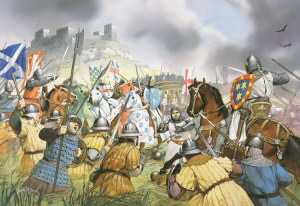 The First War of Scottish Independence began during the Middle Ages when
England attempted to claim Scotland for its own. It succeeded in gaining control
over Scotland until the nation rebelled. Robert the Bruce became a great
Scottish hero as he aided many military campaigns against the English and led
many into battle for freedom, eventually liberating his country. In a similar
way, Sir William Wallace, became immortalized for his bold military maneuvers
and became the beloved champion of Scottish rebels. Although, the First War of
Scottish Independence resulted in 5 years of Scottish freedom after the signing
of the Treaty of Edinburgh-Northampton, the English aristocracy felt humiliated
by the terms of the treaty and it was nullified by Edward III of England. This
sparked the discontent which would later result in the Second War of Scottish
Independence. The First War of Scottish Independence began during the Middle Ages when
England attempted to claim Scotland for its own. It succeeded in gaining control
over Scotland until the nation rebelled. Robert the Bruce became a great
Scottish hero as he aided many military campaigns against the English and led
many into battle for freedom, eventually liberating his country. In a similar
way, Sir William Wallace, became immortalized for his bold military maneuvers
and became the beloved champion of Scottish rebels. Although, the First War of
Scottish Independence resulted in 5 years of Scottish freedom after the signing
of the Treaty of Edinburgh-Northampton, the English aristocracy felt humiliated
by the terms of the treaty and it was nullified by Edward III of England. This
sparked the discontent which would later result in the Second War of Scottish
Independence.
King Robert the Bruce
 Robert the Bruce was born in Turnberry Castle, Ayrshire
on July 11, 1274. He lent support to William Wallace during his conquests and
became a brave Guardian of Scotland. In 1302, King Edward I “Longshanks” of
England offered a truce to the Scots which Bruce accepted and joined the English
in their ‘Scottish Council’. During a quarrel with John Comyn, a claimant to the
Scottish throne, Robert the Bruce got exceedingly angry and murdered him thus,
declaring himself King of Scotland. Fearing excommunication, Bruce traveled to
Glasgow to reconcile with the patriot Bishop of Glasgow, Robert Wishart. Instead
of excommunicating him, Wishart pardoned him and advised the people to fight for
him. They both traveled to Scone where Bruce was crowned King on March 25, 1306
and began a guerilla war with Edward I. The Declaration of Arbroath was written
and sent to the pope in Rome pleading Scottish freedom during this time. Having
defeated Edward in 1314 at Bannockburn and in 1322 during the invasion by Edward
II, the thirty years of the War of Independence were finally ended and Scotland
declared a free nation. Robert the Bruce died at Cardross on July 7, 1329. His
body was buried at Dunfermline Abbey but his heart was embalmed and taken on a
crusade to the Holy Land. The crusade, led by James Douglas, returned to
Scotland when their leader was killed in Spain. It was eventually buried by
Melrose Abbey and a new stone placed over the top of it. On the stone was
inscribed, in old Scottish, ‘A noble hart may hae nae ease, gif freedom failye’
- a noble heart may have no ease if freedom fails. Robert the Bruce risked his
title, his lands, his wealth and his title for kingship as well as
ex-communication from the pope and Catholic Church for the liberation of
Scotland. Robert the Bruce was born in Turnberry Castle, Ayrshire
on July 11, 1274. He lent support to William Wallace during his conquests and
became a brave Guardian of Scotland. In 1302, King Edward I “Longshanks” of
England offered a truce to the Scots which Bruce accepted and joined the English
in their ‘Scottish Council’. During a quarrel with John Comyn, a claimant to the
Scottish throne, Robert the Bruce got exceedingly angry and murdered him thus,
declaring himself King of Scotland. Fearing excommunication, Bruce traveled to
Glasgow to reconcile with the patriot Bishop of Glasgow, Robert Wishart. Instead
of excommunicating him, Wishart pardoned him and advised the people to fight for
him. They both traveled to Scone where Bruce was crowned King on March 25, 1306
and began a guerilla war with Edward I. The Declaration of Arbroath was written
and sent to the pope in Rome pleading Scottish freedom during this time. Having
defeated Edward in 1314 at Bannockburn and in 1322 during the invasion by Edward
II, the thirty years of the War of Independence were finally ended and Scotland
declared a free nation. Robert the Bruce died at Cardross on July 7, 1329. His
body was buried at Dunfermline Abbey but his heart was embalmed and taken on a
crusade to the Holy Land. The crusade, led by James Douglas, returned to
Scotland when their leader was killed in Spain. It was eventually buried by
Melrose Abbey and a new stone placed over the top of it. On the stone was
inscribed, in old Scottish, ‘A noble hart may hae nae ease, gif freedom failye’
- a noble heart may have no ease if freedom fails. Robert the Bruce risked his
title, his lands, his wealth and his title for kingship as well as
ex-communication from the pope and Catholic Church for the liberation of
Scotland.
Robert the Bruce’s Military Campaigns
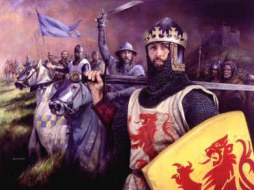 Edward Bruce, brother of Robert, invaded Ireland and led a series of revolts
against its mother-country, England. Robert the Bruce sent reinforcements,
weapons and food to him as assistance in his battle for freedom in Ireland. In
1316 he was crowned the King of Ireland, although most of the Irish clans would
not pay homage to their new ruler. He led a small army comprised of several
large Irish clans into battle against the English. They were significantly
outnumbered and in 1318 were defeated. Robert the Bruce also assisted a minor
civil war in England providing defense troops to aid the rebel leaders although
little is known about the subject. Edward Bruce, brother of Robert, invaded Ireland and led a series of revolts
against its mother-country, England. Robert the Bruce sent reinforcements,
weapons and food to him as assistance in his battle for freedom in Ireland. In
1316 he was crowned the King of Ireland, although most of the Irish clans would
not pay homage to their new ruler. He led a small army comprised of several
large Irish clans into battle against the English. They were significantly
outnumbered and in 1318 were defeated. Robert the Bruce also assisted a minor
civil war in England providing defense troops to aid the rebel leaders although
little is known about the subject.
In addition, Robert the Bruce fought his most celebrated war, the First War
of Scottish Independence. The First War of Scottish Independence began in 1297,
when William Wallace rose to prominence and began leading many influential
revolts against the insatiable English. When he was executed in 1305, Robert the
Bruce stepped up and took his place as leader of the Scottish revolution.
Killing off any rivals to the throne, Robert the Bruce was crowned king of
Scotland by the patriot Bishop of Glasgow, Robert Wishart, in 1306. He then
launched a guerilla war against England for Scottish freedom. Initially, he was
not triumphant but as his support grew he seized a large number of
fortresses-graciously allowing the enemy soldiers to return to their homelands.
After overpowering the English in the Battle of Bannockburn, King Edward III of
England signed a treaty which declared Scottish Independence.
The Scottish Battles for Freedom
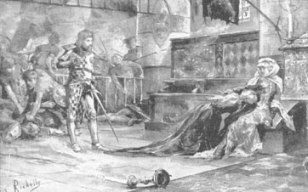 After being defeated in the Battle of Methven, Robert the Bruce abandoned his army and fled to the Orkney Isles.
Without their commander they were slaughtered and many of Bruce’s leading
captains being imprisoned. He eventually revealed himself and began attacking
the English with small raiding parties due to the lack of supplies in Scotland.
On May 10, 1307, the English army, under the command of Amyer de Valence, who
had defeated the Scots in a previous battle, made its way toward the Scottish
army through a bog. Bruce’s men had dug parallel ditches that limited room for
walking and forced the opposing soldiers to march in a long tight column.
Bruce’s soldiers swarmed downhill and massacred the English army as they stepped
out of the narrow path. Amyer de Valence managed to escape, seeking refuge at
Bothwell Castle. After being defeated in the Battle of Methven, Robert the Bruce abandoned his army and fled to the Orkney Isles.
Without their commander they were slaughtered and many of Bruce’s leading
captains being imprisoned. He eventually revealed himself and began attacking
the English with small raiding parties due to the lack of supplies in Scotland.
On May 10, 1307, the English army, under the command of Amyer de Valence, who
had defeated the Scots in a previous battle, made its way toward the Scottish
army through a bog. Bruce’s men had dug parallel ditches that limited room for
walking and forced the opposing soldiers to march in a long tight column.
Bruce’s soldiers swarmed downhill and massacred the English army as they stepped
out of the narrow path. Amyer de Valence managed to escape, seeking refuge at
Bothwell Castle.
In the summer of 1308, during both the Scottish Civil War and the First War
of Scottish Independence, John Macdougall of Lorn led clan Macdougall to battle
King Robert the Bruce. They planned a simple ambush similar to that of the
Battle of Dalry, in which King Robert I had been defeated. However, he now had
enough knowledge of guerrilla warfare to know that they awaited his arrival on a
small hillside near to Loch Awe. Having gained loyalty from a group of Scottish
Highlanders commanded by Sir James Douglas, he instructed them to attack the
Macdougall clan from the top while he confronted them from the bottom. John
Macdougall was trapped and his clan obliterated. The Lord of Argyll admitted
defeat and paid homage to Bruce as king but the next year he was banished from
Scotland along with his son, eventually dying in 1310.
The Battle of Bannockburn was a significant triumph for Scotland that decided
the fate of the entire war and declared Scottish freedom - albeit without a
written document. During this battle, Robert the Bruce adopted similar tactics
to that of the Battle of Loudoun Hill. It was during this battle that an English
commander observed Robert the Bruce seated on his horse with no armor and no
weapons save a battle-axe. The area around him was deserted so the commander
charged at him aiming his lance at his heart. Bruce stood his ground and as the
commanding officer came near he raised the blade and struck it through the
commander’s head with such force that he bore open his head along with his metal
helmet. Noting the enormity and disorganization of the English army, Robert the
Bruce sent his soldiers into the tightly packed mess until the enemy formations
began to crumble. The Scottish army began to chant ‘Lay on! Lay on! Lay on! They
fail!’ It was heard by Robert the Bruce’s camp followers who snatched up their
weapons and charged into the English. To the fatigued enemy army, this seemed
like a reserve soldiers and they gave up all hope of victory.
Sir William Wallace
|
Sir William Wallace:
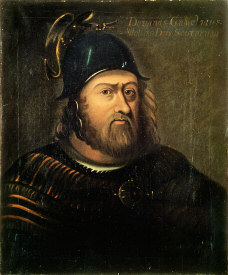
|
Robert the Bruce was certainly not the only famous rebel
leader. William Wallace was born around 1270 A.D. in Ellerslie (present day
Elderslie), Scotland to Sir Alan Wallace, Laird of Ellerslie and Auchinbothie.
He had also an elder brother, Malcolm, and a younger brother, John.
Political Background
During Wallace’s childhood, Scotland was under the rule of King Alexander
III, who had settled Scotland in a time of military peace and economic stability
and independence. He died in 1286, however, and his heir and granddaughter,
Margaret of Norway died soon after. This led to a period of instability known as
the “Great Cause” in which the government of guardians (initially established by
Scottish lords to govern until Margaret reached an age suitable to rule)
appealed to Edward I of England to decide between the contenders for the throne.
This dissension seemed to be the prolepsis of a civil war, and as a result, King
Edward was summoned by the Scottish nobles to mediate. However, before
undertaking the affair, he demanded that the rivals for the throne acknowledge
him to be “Lord Paramount of Scotland”. Eventually, the weak John Balliol was
found to have the strongest legal claim to the throne and was crowned king.
Edward I continued to veto or alter the adjudications of the Scottish Lords and
attacked the Scottish border town of Berwick-upon-Tweed in 1296. By July, he had
forcibly coerced Balliol to relinquish his throne and gradually used his power
to force Scotland under the thumb of English rule.
Biography
William Wallace spent his childhood at Dunipace near Stirling,
where his uncle, a priest cared for him and here Wallace led a contented and
quiet life as the son of nobility.
Infamous Battle of Stirling Bridge
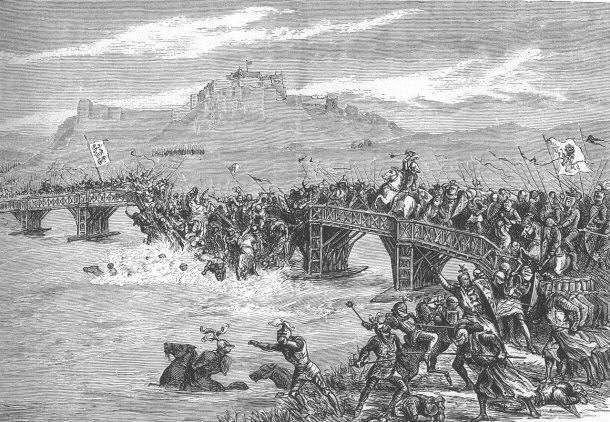
He grew to be a large man of approximately
two metres in height who was very powerful physically and wise. Both he and his
brother Malcolm were trained in the art of combat and horsemanship. The Life of
Sir William of Ellerslie Carrick described William Wallace in an awed
description, seeming to rival Homer’s depiction of Achilles:
“All powerful as a swordsman and unrivaled as an archer, his blows were fatal
and his shafts unerring: as an equestrian, he was a model of dexterity and
grace; while the hardships he experienced in his youth made him view with
indifference the severest privations incident to a military life.”
Modern-day Stirling, Scotland with Old Stirling Bridge and
the Abbey Craig
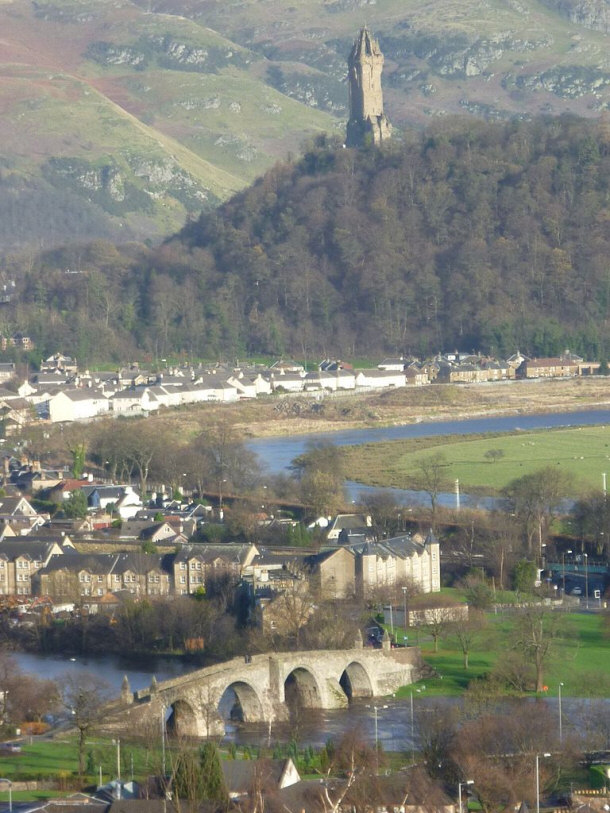
By Kim Traynor
via Wikimedia Commons
Wallace’s father was murdered in a fight with English troops in 1291 when
William was 21 years old. This event contributed to Wallace’s lasting desire to
fight for the cause of Scottish freedom. He spent the next part of his life as
an outlaw, viciously confronting the English on occasion. In 1297 the English
sheriff of Lanark, Sir William Haselrig, murdered Marion Braidfute, his wife. In
his anger Wallace took revenge by killing the Sheriff and some others with the
assistance of John Graham. By April the entire of North Scotland was under
revolt. Andrew de Moray led a small army to destroy every English garrisoned
fortress from Banff to Inverness.
The news of William Wallace’s attack had spread throughout Scotland and many
rebels joined together under his leadership. Supported by the Bishop of Glasgow,
the rebels planned an attack on Scone to defeat the Justiciar of Scotland,
William Ormesby, who was appointed by the English. Ormesby was warned of the
coming attack and fled. While laying siege to a castle, William received news
that the English army was advancing north led by the Earl of Surrey. Wallace and
de Moray traveled to Cambuskenneth Abbey with their armies and combined their
forces while they awaited the English. On September, 1297 the English and
Scottish armies met in the Battle of Stirling Bridge. This was the first
significant success for the Scots. William Wallace spoke to the surviving
English:
 ‘I’m William Wallace, and the rest of you will be spared. Go back to England
and tell them…Scotland is free!’ ‘I’m William Wallace, and the rest of you will be spared. Go back to England
and tell them…Scotland is free!’
In March 1298, William Wallace was knighted and became the official Guardian
of the Kingdom of Scotland. But, on July 22, 1298, King Edward ‘Longshanks’ I of
England sent a large army to attack William Wallace’s significantly smaller
army. Wallace’s army was decimated by Edward’s cavalry and spearmen and he fled
to the nearby forest, resigning his supervision in December. He was found and
sentenced to be hanged, drawn and quartered on August 23, 1305 at the Elms of
Smithfield in the traditional conduct for all outlaws. The four remaining parts
of his body were exhibited separately in Berwick, Stirling, Newcastle and Perth
and his head was displayed on a stick on London Bridge as a warning to all
people, both Scots and English. Sir William Wallace of Ellerslie prepared the
way for Scottish freedom.
The Treaty of Edinburgh-Northampton
Thirty years later, in 1328, the treaty
of Edinburgh-Northampton was signed by the rulers and several important nobles
of both countries. It officially declared Scotland liberated and a made truce
between the two opposing countries. The terms of the treaty stated that, in
return for £100,000 sterling, England would acknowledge Scotland to be an
entirely independent nation and recognize Robert the Bruce and his successors as
its lawful rulers. However, the treaty was disliked by much of the English
nobility and was abrogated in 1333 by Edward III, sparking the discontent that
would eventually lead to the start of the Second War of Scottish Independence.
COOL FACT: Did you know the movie "Braveheart "
was made to showcase this exact war? I recommend watching it if you
haven't yet! "
was made to showcase this exact war? I recommend watching it if you
haven't yet!
History
Top Lists:
15 Biggest Architectural Blunders
Top 15 Most Horrifying Terrorist Attacks
15 Fascinating Facts About the Vietnam War
Top 15 Amazing Ancient Egyptian Architecture
20 Little Known Facts About the Titanic
Top 10 Most Creepiest Abandoned Places in the World
26 Interesting Facts About Henry Ford
List of 15 Tough Ancient Warriors Through History
List of 15 Notorious Roman Emperors and Empresses
Top 15 Worst Pandemics in History
15 Things That Remained the Same in the Past 100 Years
Top 15 Things China Invented First
Top 15 Greatest Inventors in History
15 Interesting Facts About Abraham Lincoln
10 Inventors Who Stole Their Ideas
15 Stories of Hilarious Medieval Victories
15 Detectives Credited With Solving The Biggest Cases In History
15 Fascinating Facts About the Ancient Pyramids
15 Inventions That Were the Result of a Mistake
15 Famous Stories of Execution
16 Rare Facts About the U.S. Presidency
15 Astonishing Leadership Stories that Ended up Successfully
Informational:
Analysis of the Linear B tablets and Wall Paintings
Aristophanes and Classical Greek Comedy
The First War of Scottish Independence
|